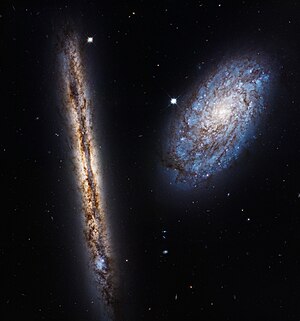NGC 4298
| Galaxy NGC 4298 |
|
|---|---|

|
|
| NGC 4302 & NGC 4298, Hubble Space Telescope | |
| AladinLite | |
| Constellation | Berenike's hair |
|
Position equinox : J2000.0 , epoch : J2000.0 |
|
| Right ascension | 12 h 21 m 32.7 s |
| declination | + 14 ° 36 ′ 22 ″ |
| Appearance | |
| Morphological type | SA (rs) c / HII |
| Brightness (visual) | 11.4 mag |
| Brightness (B-band) | 12.1 mag |
| Angular expansion | 3.2 ′ × 1.9 ′ |
| Position angle | 140 ° |
| Surface brightness | 13.2 mag / arcmin² |
| Physical data | |
| Affiliation | Virgo cluster Messier 87 group NGC 4639 group LGG 289 |
| Redshift | 0.003786 ± 0.000013 |
| Radial velocity | 1135 ± 4 km / s |
|
Stroke distance v rad / H 0 |
(49 ± 3) x 10 6 ly (14.9 ± 1.0) Mpc |
| history | |
| discovery | William Herschel |
| Discovery date | April 8, 1784 |
| Catalog names | |
| NGC 4298 • UGC 7412 • PGC 39950 • CGCG 099-024 • MCG + 03-32-007 • IRAS 12190 + 1452 • 2MASX J12213279 + 1436217 • VCC 483 • GC 2874 • H II 111 • h 1198 • LDCE 904 NED060 • HOLM 377A • KPG 332A • EVCC 412 | |
NGC 4298 is a regularly shaped spiral galaxy with extensive star formation areas in the constellation Haar der Berenike in the northern sky . It is estimated to be 49 million light years away from the Milky Way and has a diameter of around 45,000 ly. Together with the edge-on galaxy NGC 4302 , it forms the heavily gravitationally bound galaxy pair Holm 377 or KPG 332 . It is registered as a member of the Virgo galaxy cluster under catalog number VCC 483 .
In the same area of the sky are the galaxies NGC 4262 , IC 781 , IC 3177 and IC 3238 , a few degrees to the east the three giant galaxies M87 , M89 and M90 , whose gravity dominates the dynamics of the galaxy cluster.
The object was discovered on April 8, 1784 by the astronomer Wilhelm Herschel with the help of his 18.7 inch reflector telescope.
